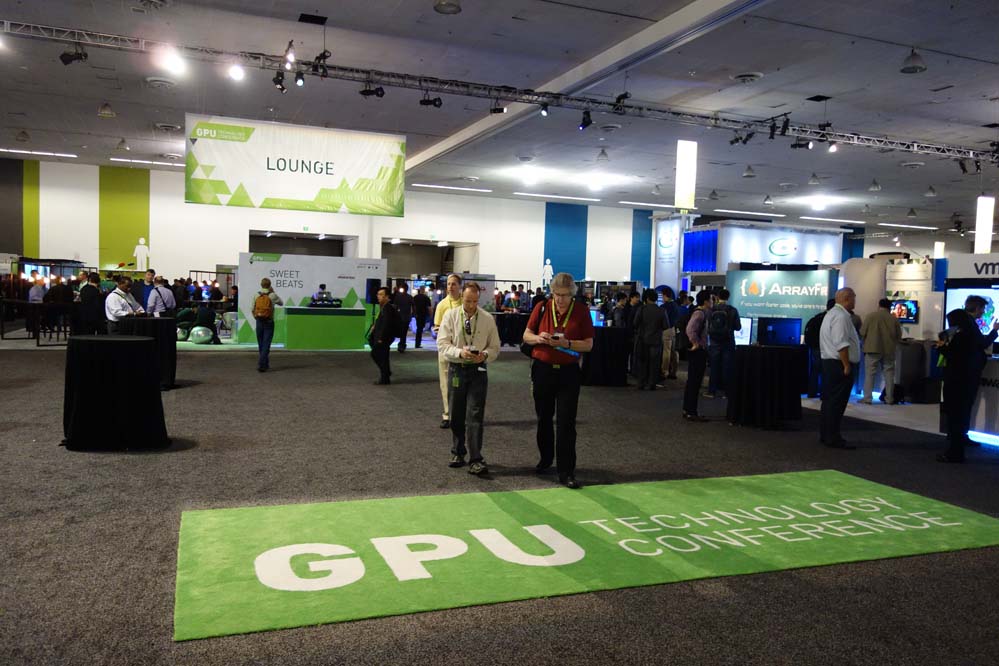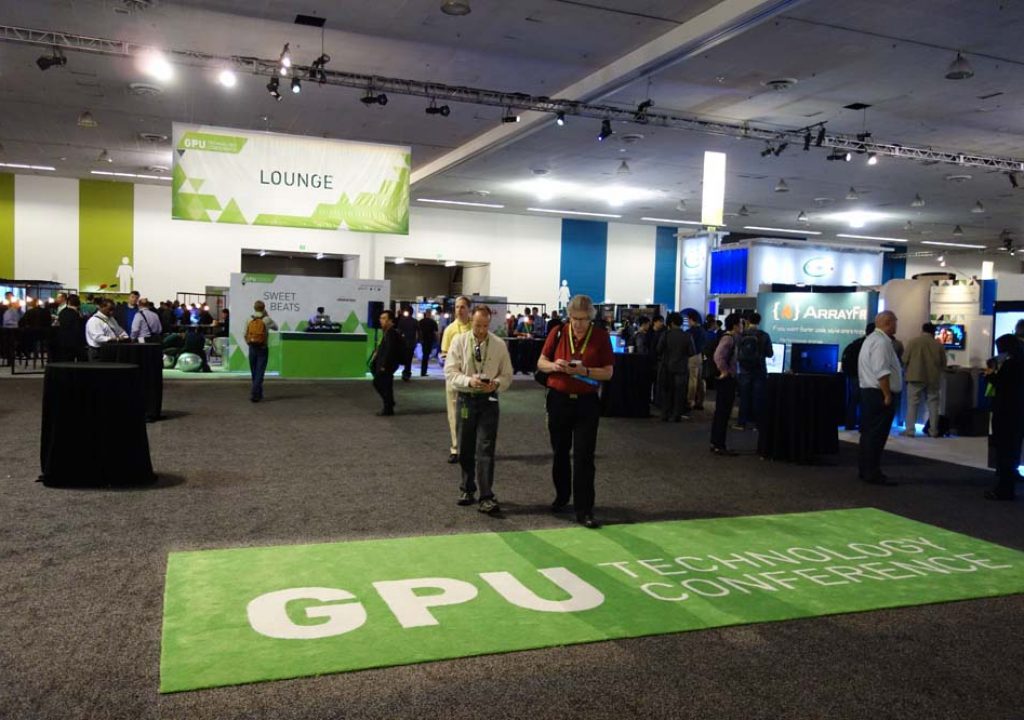
NVIDIA’s GPU Technology Conference is impressive in both scale and scope. The conference is geared toward professionals who are working on the technical side of things in various markets and verticals, which is probably why you see so many people walking around with PC’s. Charts, numbers and code are all over the place, but their prominence underscores how and why such things are of critical importance.
PVC writers like Scott Simmons have drilled into how we might be able to use some of NVIDIA’s technology to extend the life of an old Mac Pro, and you don’t need to look far to find out how their GPU influences filmmaking projects of all shapes and sizes. But the GPU Tech Conference is about so much more than M&E. A quick glance at their schedule shows over 40 different areas of focus that includes Media & Entertainment, but also includes everything from Astrophysics to Visualization. The amount of applicable realizations of this technology is incredible and the approach goes far beyond the technology we’re dealing with today.
But that’s just one aspect of what NVIDIA had in store for attendees.
Future Focused
The conference is the largest event of the year for GPU developers and the entire ecosystem, and that reality was evident from the opening keynote when NVIDIA CEO Jen-Hsun Huang addressed the massive crowd to talk through their four key announcements that all dealt with the concept of “deep learning” in one way or another. Those announcements include details around the Titan X and Pascal, as well as the DIGITS DevBox and NVIDIA Drive PX.
At its core, deep learning is about getting computers and networks to think on a deeper and more intuitive level. The goal is to get a computer to identify something it is unfamiliar with based on the info it has available. Sometimes that works well, and the computer can deliver an accurate description of an image it has never seen before…
Other times not so much.
Nonetheless, the focus clearly isn’t on the struggles or stumbling blocks of today. It’s about where the technology is taking us, and famous clips from 2001 and Star Trek were used to show that we’re simultaneously living and headed to the future.
It’s something that’s especially relevant for automated cars, where the computer will need to “think” on its own to identify what it needs to do in certain situations. Elon Musk came out for a quick chat with Huang to discuss some of those details, and what stuck with me most was how he pointed out that not too long ago elevators needed operators, but that sort of control is no longer necessary. How long before we’ll be able to say the same thing about cars?
We often talk about disruption, and the use of that word to describe the constant changes in the industry convey a general sense of how many people view them. But that word was never once mentioned by Huang, and that’s no coincidence. Everything they’re developing is with an eye toward how it will be used and changed in the future, and they don’t view that process disruptive, but as a necessary part of progress.
He mentioned the possibilities being endless, and after hearing him talk as much about how much we can do today and how much more we’re going to do tomorrow, it’s easy to believe him.
The Exhibit Hall
The exhibit space featured large exhibit spaces for both HP and Dell, and Dell used the opportunity to announce that its Precision and Wyse brands are joining forces to introduce the Dell Precision Appliance for Wyse. It’s the first ever ISV-certified virtual workstation appliance for graphic intensive environments.
For anyone interested in talking render power or capability, you had more than a few options in terms of both exhibitors and attendees, and everyone couldn’t wait to drill into the specs around what they were looking for or showcasing.
GPU’s, Holodecks and a New Age for Creativity
My focus for the day was around the sessions though, and there were a number that were centered on the M&E. I was tempted to make my way over to either “The Future of Human Vision or “VR Everywhere”, but decided it would be better to stick with something that I could conceivably wrap my head around.
Creating CONSTRUCT: A GPU-Rendered Short Film was the first one up, and it was also a big highlight of the day, possibly because it showed the end result more than any other session. It’s easy to get caught up in conversations about power and capabilities, but when you get to see what off this can and does mean on screen, it affects you in a real way.
Writer, producer and director Kevin Margo talked about how Chaos V-Ray RT and NVIDIA GPUs were used throughout production on his short film CONSTRUCT, which was rendered entirely on GPUs. He showed the audience a few clips of the film, one of which is available online. I’ve embedded it below just to give you a sense of the capabilities he discussed in detail.
Construct GTC Teaser from Kevin Margo on Vimeo.
Vladimir Koylazov and Blagovest Taskov talked through Advancements in V-Ray RT GPU, and shared technical details around implementations on the GPU for hair raytracing and sub-surface scattering, but also discussed more efficient cloud rendering and improved raytracing acceleration. That session was labeled as “advanced”, and they weren’t kidding around. Anyone who wants to really explore how this technology can and does work should learn more about the folks behind Chaos Software.
The CEO & Founder of OTOY Inc., Jules Urbach presented a session titled So You Want to Create the Holodeck? A Closer Look at OTOY’s Lightfield Technology where he showcased a 20th century take on VR to the packed audience. OTOY is dedicated to redefining content creation and delivery for media and entertainment organizations around the world, and they’re looking to push VR awareness to everyone. The power of VR is more real than ever, and we’re at a point where these immersive environments have practical uses that everyone needs to be aware of. Urbach talked through how and why their product is totally free, even for commercial use, and their goal is to keep it that way.
I made it a point to not dwell on too many of the technical specifics, because these presenters only had less than a half an hour to get through their presentations and needed to make sure they talked through the essentials. Each one of these sessions could be an entire article, but the essence of each more or less dealt with giving people the sort of technical power they needed to work through their project, and those projects were either a labor of love or on a level of a very small production house, which should give you an idea around the availability of this technology.
The balance between the technical and creative side of a project can be a delicate one, and that’s something that you can easily forget when you’re focused on charts, numbers and code.
Stay Tuned for Day 2
I’ll have more from the GPU Technology Conference tomorrow, including info on the keynote from Jeff Dean, an exclusive interview and a few final thoughts. In the meantime, check out some pictures from Day 1…
Disclosure: My flight, hotel and all access press pass were comped by the presenters of this conference.

